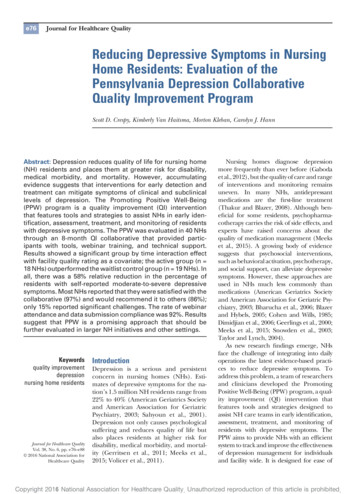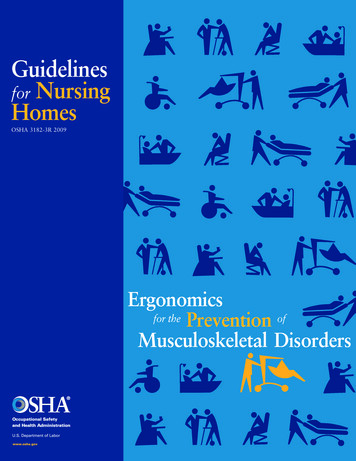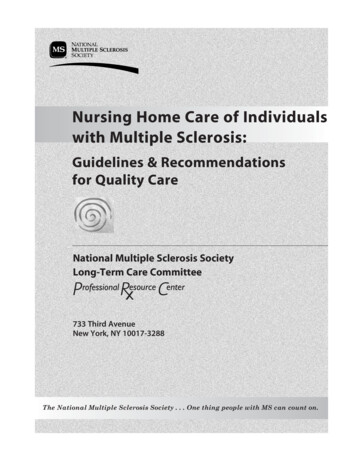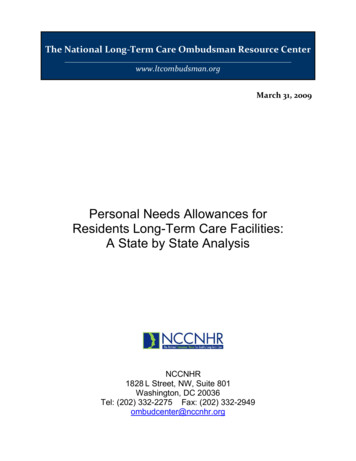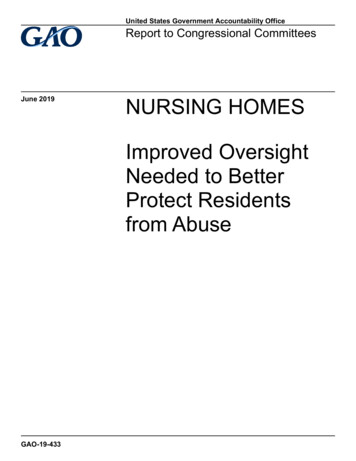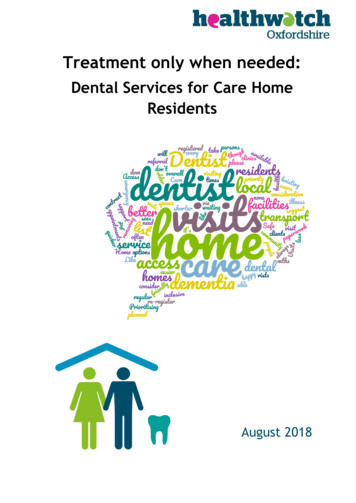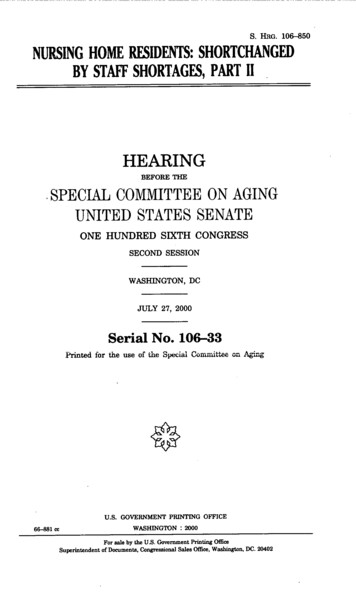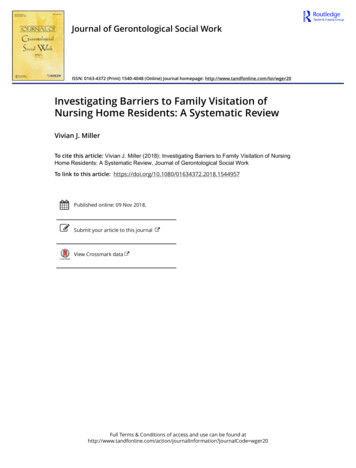
Transcription
Journal of Gerontological Social WorkISSN: 0163-4372 (Print) 1540-4048 (Online) Journal homepage: http://www.tandfonline.com/loi/wger20Investigating Barriers to Family Visitation ofNursing Home Residents: A Systematic ReviewVivian J. MillerTo cite this article: Vivian J. Miller (2018): Investigating Barriers to Family Visitation of NursingHome Residents: A Systematic Review, Journal of Gerontological Social WorkTo link to this article: shed online: 09 Nov 2018.Submit your article to this journalView Crossmark dataFull Terms & Conditions of access and use can be found tion?journalCode wger20
JOURNAL OF GERONTOLOGICAL SOCIAL nvestigating Barriers to Family Visitation of Nursing HomeResidents: A Systematic ReviewVivian J. MillerSchool of Social Work, University of Texas at Arlington, Arlington, TX, USARTICLE HISTORYABSTRACTFamilies are integral in helping nursing home residents maintain feelings of social inclusion and an overall sense of belonging, thus reducing consequences of social exclusion.Preliminary research, particularly of the culture change movement in long-term care, shows there are barriers to familyengagement and visitation of residents. The objective of thisstudy is to: (1) identify and summarize the barriers mostreported to family visitation and (2) synthesize the findings todetermine which barriers are most often reported in literature,and which may pose the greatest challenges to family involvement. Using the Preferred Reporting Items for SystematicReviews and Meta-Analyses (PRISMA) guidelines, a final sampleof 15 articles across 11 databases report seven barriers tovisitation: psychological, health, staff to family member relationship, employment/finances, travel time, access to transportation, and other. Findings suggest barriers to family visitationand point toward a need for further research as relationshipsbetween resident and family member is complex and warrantsattention across professions. Interprofessional efforts betweensocial work, allied professionals, and transportation plannersare necessary to address this pressing concern experienced byresidents in nursing homes, with the ultimate goal of lesseningsuch barriers.Received 17 June 2018Accepted 2 November 2018KEYWORDSLong-Term Care;Friendships/Social Networks/Social Support; Quality ofLifeIntroductionResidents of nursing homes may miss face-to-face connection with lovedones. At times, older adult residents transition from living at home in thecommunity with family to residing in long-term nursing home care, wherethey often face isolation and may lack strong social connectivity, which inturn can lead to feelings of loneliness (Price, 2015; Steptoe, Deaton, & Stone,2015). Loneliness can be defined as the unmet needs of one needing tobelong and is addressed in the seminal work by Baumeister and Leary(1995). Human beings fundamentally need to belong (Heinrich & Gullone,2006) and a lack of belongingness can result in anxiety, depression, and poorhealth (Baumeister & Leary, 1995). This is especially important to be aware ofCONTACT Vivian J. Millervivian.miller@mavs.uta.eduArlington, 211 South Cooper Street, Arlington, TX 76019 2018 Taylor & Francis Group, LLCSchool of Social Work, University of Texas at
2V. J. MILLERin older adult nursing home (NH) residents, who most often experiencedecreased functional ability and physical dependence (Valenzuela, 2012),increased rates of depression (Stewart, 2013), high levels of cognitive impairment (Schussler & Lohrmann, 2017), and other acute health problems (i.e.,incontinence, vascular disease, and musculoskeletal disorders) (VanRensbergen & Nawrot, 2010). NH residents do have frequent contact andcommunication with NH staff, but this communication often focuses on caretasks, which includes assessing functional status and technical care (Lee, Lee,& Armour, 2016) and may do little to alleviate loneliness.Family members help maintain social connection through visitation andthe provision of personalized care (Gaugler, 2005; Yamamoto-Mitani,Aneshensel, & Levy-Storms, 2002). Positive social interactions and socialconnection between residents and family members have been found toreduce loneliness (DeWall, 2013). Even more so, these positive connectionsare found to counteract the consequences of social exclusion (DeWall, 2013).Many family members take on the role as resident advocate by monitoringthe quality of care provided and help staff in detecting changes in residenthealth status (Gaugler, 2005; Powell et al., 2017). While many family members aim to remain socially connected with their loved one in a NH, there aremany challenges and barriers in doing so including the health of caregivers,commitments to work, and financial constraints (Strain & Maxwell, 2015;Yamamoto-Mitani et al., 2002). Additionally, travel time, which, at times,may be referred to as proximity, and access to transportation are significantbarriers to family members’ visitation and this leads to social isolation andexclusion of residents (Parmenter, Cruickshank, & Hussain, 2012; Port,2004).This involvement in care of family members to residents of nursing homes(NHs) is found to be critical to the well-being and quality of life of olderadults, and is key to person-centered care (Koren, 2010). Person-centeredcare, a feature of the culture change movement across nursing homes andlong-term care, aims to improve the overall quality of life of residents(Grabowski et al., 2014). This culture change movement focuses on bothfamily visitation, involvement, and engagement, as well as staff developingrelationships with residents that goes beyond just the basic care tasks(Corazzini et al., 2015). A better understanding of the connections betweenfamily members’ access and involvement to visitation of residents isa fundamental component to overall improve these opportunities.Given the negative consequences the lack of family visitation has onresidents, as well as the growth of the older population, the number ofolder Americans requiring NH care may increase 75%, from 1.3 millionin 2010 to 2.3 million by 2030 (Population Reference Bureau, n.d.), it isan especially important time to best understand the barriers that inhibitthe connections between family members and residents. No systematic
JOURNAL OF GERONTOLOGICAL SOCIAL WORK3review identifying the barriers to family visitation of NH residents hasbeen done before. Therefore, this research aims to address the followingobjectives: (1) identify and summarize barriers to family visitationbetween loved ones of nursing home residents and (2) synthesize thefindings to determine which barriers are most often reported in literature, and which may pose the greatest challenges to family involvement.The article concludes with implications for future research and practice.MethodThis review was conducted using the Preferred Reporting Items forSystematic Reviews and Meta-Analyses (PRISMA) (Moher, Liberati,Tetzlaff, & Altman, 2009) guidelines. The PRISMA guidelines are an evidence-based methodology to investigate, systematically, a body of literatureon a particular topic or concept (Liberati et al., 2009). This methodologyprovides a transparent, accurate approach to reporting articles, and has beenused widely in literature across professions, such as healthcare (Liberati et al.,2009), psychiatry (Rivero, Nunez, Pires, & Bueno, 2015), and social work(Smith-Osborne & Felderhoff, 2014).Data collection – search strategyThe databases searched include Academic Search Complete, AgeLine,AltHealthWatch, CINAHL Complete, Health Source – Consumer Edition,Health Source: Nursing/Academic Edition, MEDLINE, PsycARTICLES,Psychology and Behavioral Sciences Collection, PsycINFO, and Social WorkAbstracts for articles published in English between January 1, 1997 andNovember 9, 2017. The key terms and phrases for the search were: “longterm care or nursing home,” “barriers or obstacles or challenges,” “socialexclusion or socially excluded or social isolation,” “isolation,” “visit*,” “contact,” and “family or families or relatives or parents or siblings.” There was anasterisk placed at the end of the stem search term “visit” to capture articles thatused variations of this term, for instance “visitation.” A similar search wasdone using Google Scholar, though no additional articles were found. To beincluded in the review, articles had to meet the following criteria: (a) bepublished in a peer-reviewed, scholarly journal; (b) identify a barrier to familyand/or caregiver visitation to residents in U.S. nursing homes; and, (c) explicitly include residents aged 65-years old and above. Articles were excludedfrom the final sample if they were not written in English, were book reviews,editorials or policy briefs, and did not report a barrier to family visitation ofresidents in nursing homes.
4V. J. MILLERArticle selectionThese searches identified 1,928 articles, some of which were duplicatesyielding a total of 1,109 separate articles. The full process for article inclusionis shown in Figure 1 (Figure 1 about here). The criteria for excluding articlesare shown in Table 1 (Table 1 about here). Nine hundred and eight articleswere excluded because inclusion criteria were not met in title and abstract.One hundred and eleven articles of those remaining were excluded becauseinclusion criteria were not met in the full-text of the article. Four (n 4)additional articles were identified after a hand-checked review of referencesin the original 11 articles. The final 15 articles (n 15) of the data set arelisted in Table 2. (Table 2 about here).Data extractionTwo independent reviewers screened the final sample of articles andextracted data from the final articles. In cases which were unclear, consensuswas reached by discussion between the reviewers. Quantitative articles wereassessed based on: sample size, internal validity, analytical methods, andFigure 1. Flowchart of study selection protocol, guided by PRISMA (Moher, 2009) guidelines.
JOURNAL OF GERONTOLOGICAL SOCIAL WORK5Table 1. Exclusion of articles.ExclusionNot EnglishNot United StatesNot Nursing HomeNot Older AdultsNot reporting barriers to visitationOther (e.g., book review, editorial, policy brief)Title & plicit versus implicit examination of barriers (e.g., empirically studyingbarriers to visitation). Qualitative articles were assessed based on: analyticalmethods and explicitly studying barriers to visitation. No articles included inthe final sample employed mixed-methodological study designs. Seven articles of the total sample were review articles. Table 4 includes the final sampleof articles, as well as the study methodology, sample size, and design of eachstudy (Table 4 about here).ResultsSeven barriers to the visitation by family members of residents in nursinghomes, which can be classified as internal and external barriers, are describedin the 15 articles. These barriers, listed in Table 3, are: (1) psychological, (2)health, (3) staff-to-family-member relationship, (4) employment/finances, (5)travel time, (6) access to transportation, and (7) other (Table 3 about here).Description of the barriersInternal barriersPsychologicalPsychological barriers to NH visitation include guilt, depression, and feelingsof being emotionally overwhelmed, heartbroken, and uncomfortable whenvisiting the nursing home. These barriers are the most complex to describeand one of the most widely reported. Nine of the 15 papers report psychological factors as barriers to family members visiting their loved ones. Thisbarrier most often posed challenges for the family members (Bern-Klug,2008; Flinders, 2003; Gaugler, Leitsch, Zarit, & Pearlin, 2000; Gwyther,2001; Janzen, 2001; Mickus & Luz, 2002; Port et al., 2001; Webster et al.,2016; Yamamoto-Mitani et al., 2002).Flinders (2003) reported “Family members may feel upset about theirloved one living outside of the family unit and struggle with the changesassociated with aging and nursing home placement” (p. 258). It was alsoreported that feelings of dislocation, in addition to other psychologicalfactors, such as depression, can cause families to rarely visit the NH.
02Flinders, S.L.Friedemann et al.Gaugler, J.E. et al.Gwyther, L.P.Janzen, W.Levine, C. & Kuerbis, A.Mickus, M.A. & Luz, C.C.Parker Oliver, D. et al.Port, C.L. et al.Port, C.L.Webster et al.Yamamoto-Mitani et al.JournalJournal of the AmericanMedical Directors AssociationJournal of NeuroscienceNursingAging & Mental HealthJournal for thePsychoanalysis of Culture &SocietyFamily involvement in the nursing homeWestern Journal of NursingResearchCaregiver involvement following institutionalizationResearch on AgingFamily caregivers and long-term care: caring togetherAlzheimer’s Care QuarterlyLong-term care for older adults: the role of the familyJournal of GerontologicalNursingBuilding alliances between social workers and family caregiversJournal of Social Work inLong-Term CareTelevisits: sustaining long distance family relationships among institutionalized elders Aging & Mental Healththrough technologyA promising technology to reduce social isolation of nursing home residentsJournal of Nursing CareQualityResident contact with family and friends following nursing home admissionThe GerontologistIdentifying changeable barriers to family involvement in the nursing home forThe Gerontologistcognitively impaired residentsMental health concerns of older adults living in long-term care facilities: an area of The American Journal ofexpansion for MFTsFamily TherapyPatterns of family visiting with institutionalized elders: the case of dementiaJournal of Gerontology:SOCIAL SCIENCESDepression in older nursing home residents: The influence of nursing homeenvironmental stressors, coping, and acceptance of group and individual therapyThe internal struggles of agingDate ofPublicationTitle of Article2008The emotional context facing nursing home residents’ families: a call for rolereinforcement strategies from nursing homes and the community2003The psychosocial impact of late-stage Parkinson’s diseaseChoi, N.G. et al.Calne, S.M.AuthorsBern-Klug, M.Table 2. Articles included in the final /PageIssueNumbers936–446V. J. MILLER
JOURNAL OF GERONTOLOGICAL SOCIAL WORK7Table 3. Barriers described in article data set and number ofarticle describing each t/FinancesProximityTransportationStaff/Family RelationshipsOtherNumber of Articles91038494Gwyther (2001) reported family members may have an emotionally difficulttime visiting a loved one because of cognitive decline of the resident. Forsome, it may be emotionally overwhelming and heartbreaking to witnessa loved one’s personality changes associated with dementia, which in turnmay cause a decrease in the number of or even a lack of visits.HealthThe Health barrier refers to the health of family members outside the nursinghome and health of the resident in the nursing home. Ten of the fifteenarticles report that people have trouble visiting nursing homes when they orother family members have health needs of their own (Bern-Klug, 2008;Calne, 2003; Choi, Ransom, & Wyllie, 2008; Friedemann, Montgomery,Rice, & Farrell, 1999; Gaugler et al., 2000; Gwyther, 2001; Janzen, 2001;Levine & Kuerbis, 2002; Mickus & Luz, 2002; Parker Oliver, Demiris, &Hensel, 2006). Calne (2003) suggested that the health decline of familymembers/caregivers was the strongest precursor to nursing home placement.In other words, decline of the caregiver’s health eventually became thedeciding factor for nursing home placement. After placement of the lovedone in the nursing home, the caregiver or family member may becomeacutely sick leaving the nursing home resident without support (Calne,2003). Similarly, two studies (Gwyther, 2001; Levine & Kuerbis, 2002) identified that family members (former caregivers) can be overwhelmed withtheir own health concerns, such as fatigue associated with cancer treatment,which leaves them less able to focus on the needs of the loved one in thenursing home.Staff-to-family-member-relationshipThe relationship between the nursing home staff and the family member is listedas a barrier because in nine articles the relationships between facility staff andfamily members were found to influence family member involvement in care(Calne, 2003; Gaugler, 2000; Gwyther, 2001; Janzen, 2001; Levine & Kuerbis,
Review ArticlesQualitativeTitle and DateThe emotional context facing nursing homeresidents’ families (2008)Caregiving involvement followinginstitutionalization (2000)Televisits: sustaining long distance familyrelationships (2002)Identifying changeable barriers to familyinvolvement in nursing homes (2004)Family involvement in the nursing home (1999)Resident contact with family and friendsfollowing nursing home admissionPatterns of family visiting with institutionalizedelders: The case of dementiaDepression in older nursing home residents:(2008)Calne, S.M.The psychosocial impact of late-stageParkinson’s disease (2003)Flinders, S.L.The internal struggles of aging (2003)Gwyther, L.P.Family caregivers and long-term care: caringtogether (2001)Levine, C. & Kuerbis, A.Building alliances between social workers andfamily caregivers (2002)Parker Oliver, D., Demiris, G., &A promising technology to reduce socialHensel, B.isolation of nursing home residents (2006)Webster, T.N., Yorgason, J.B., Maag- Mental health concerns of older adults living inWinter, A., Clifford, C., et al.long-term care facilities: (2016)Janzen, W.Long-term care for older adults, the role of thefamily (2001)Friedemann, M-L., Montgomery, R.J., Rice, C., & Farrell, L.Port, C.L., Gruber-Baldini, A.L.,Burton, L., Baumgarten, M., et al.Yamamoto-Mitani, N., Aneshensel,C.S., & Levy-Storms, L.Choi, N.G., Ransom, S., & Wyllie, R.J.Port, C.Author(s)Survey and secondaryBern-Klug, M.data analysis designsQuantitativeGaugler, J.E., Leitsch, S.A., Zarit, S.H.,& Pearlin, L.I.Mickus, M.A. & Luz, C.C.Table 4. Results of data extraction.65 nursing homeresidents1,441 significantothers of residents210 caregiversMultivariate regression185 primarycaregivers20 residents andfamily members98 family andresident pairs216 family membersReview articleReview articleReview articleReview articleReview articleReview articleReview articleSemiparametric, group-based methodusing a latent class mixture modelIn-depth interviewsPearsons correlationRegression analysesRegression modelingBrief surveys pre- and post- on effectDesignQualitative ethnographic dataSample Size44 family members8V. J. MILLER
JOURNAL OF GERONTOLOGICAL SOCIAL WORK92002; Parker Oliver et al., 2006; Port, 2004; Port et al., 2001; Yamamoto-Mitaniet al., 2002). Janzen (2001) reports that the positive staff to family relationshipscould encourage and promote involvement. Conversely, disagreements andmisunderstandings between family and staff may discourage family involvementand engagement in care (Janzen, 2001). For family members who are apprehensive and unsure about their new role after placing a loved one in the nursinghome, staff should help with this transition (Gwyther, 2001). Similarly, Levineand Kuerbis (2002) highlight that the relationship between staff and familymember is crucial. Family members should feel confident and assured of thestaff of the facility when they place their loved ones in the nursing home. Theresident’s care is one of the most important considerations of family members,and a “family caregiver should feel confident that if illness, weather, or anotherevent precludes visiting, the resident” (Levine & Kuerbis, 2002, p. 14) the NHresident would still be cared for.External barriersEmployment/FinancesThe Employment/Finances barrier includes ability of family members to taketime off at work and their means to pay for the visits. Three of the 15 articleseither state Employment/Finances were a predictive factor related to reducedvisitation or links this factor to other contributing factors (Bern-Klug, 2008;Friedemann et al., 1999; Port et al., 2001). Bern-Klug (2008) found financialworries and concerns with paid employment affect family members ability tovisit their loved one in the nursing home. A similar study (Port et al., 2001)found that more financial resources may facilitate contact in several waysbecause higher socioeconomic status results in fewer practical barriers tovisitation and phone calls and reduces the risk of losing a job when takingoff work for visits. That study showed those who have more financial freedommay have the ability to visit their nursing home resident more frequently andconsistently. Gaugler et al. (2000), on the other hand, found those with highereducation (e.g., high school, some college, college or more) and more financialflexibility may actually visit nursing home residents less frequently and theorized that those who have more financial resources can place loved ones infacilities that are a better match for residents’ care needs, which can give familymembers a sense that the care is good, and they do not need to be as involved.Travel TimeThe Travel Time barrier is related to time travel from family member’s houseor work to the nursing home, e.g., mileage, driving time, and proximity.Visiting the nursing home resident can be a challenge, especially when familymembers have to travel, what is perceived to be, a long distance to the
10V. J. MILLERnursing home facility. A short commute to the nursing home is associatedwith more frequent visits, as reported in the study conducted by YamamotoMitani (2002). Eight studies (Bern-Klug, 2008; Gaugler et al., 2000; Janzen,2001; Mickus & Luz, 2002; Parker Oliver et al., 2006; Port, 2004; Port et al.,2001; Yamamoto-Mitani et al., 2002) reported travel time (or travel distance)to the nursing home was negatively associated with family visits. In some ofthe articles, travel time, coupled with the relative’s duration of residency,impacted frequency of visits to the nursing home.Access to TransportationThe Access to Transportation barrier is related to a means of transportationto the nursing home, including access to an automobile. One study by Portet al. (2001) using interviews conducted with the significant others of 1,441nursing home residents in Maryland, found that the variable of transportation was most predictive of difficulty to frequency of visits when consideredin the context of transportation. People who have a transportation disadvantage are those, “unable to provide their own transportation or even use publictransportation” (United States General Accounting Office, 2003, p. 1). Thiswas a barrier identified in 4 of the 15 studies (Bern-Klug, 2008; Choi et al.,2008; Port, 2004; Port et al., 2001).OtherOther factors that have been found associated with lower visitation of familyto residents in nursing homes visits include race, gender, weather conditions,and other relationship, which have been reported in six articles (Friedemannet al., 1999; Janzen, 2001; Levine & Kuerbis, 2002; Port, 2004; Port et al.,2001; Yamamoto-Mitani et al., 2002). Janzen (2001) found that when familymembers are involved in the care of their loved one once placed in thenursing home it is the gender of the family member that dictates the level ofinvolvement. While Janzen (2001) pinpointed gender-specifics in thatwomen visit more frequently than men, Friedemann et al. (1999) foundthat it is the eldest daughter of a nursing home resident who tends to assumethe role as first contact and primary caregiver to their resident.Port et al. (2001) found that African-American residents had fewer visitsfollowing admission, “due to an increase in the other identified barriers (e.g.,socioeconomic status, greater work obligations impeding the ability to visit,paying for transportation, and other practical barriers)” (p. 594). Anotherbarrier to visitation, noted by Levine and Kuerbis (2002), is weather. Weathermay deter family members from visiting for a number of reasons includingsafety and issues in driving. Finally, spousal partnerships and parenting isnoted to impact frequency of visitation (Yamamoto-Mitani et al., 2002). NH
JOURNAL OF GERONTOLOGICAL SOCIAL WORK11residents who are widowed, single, and those who do not have children mayhave extremely low levels of visitation (Yamamoto-Mitani et al., 2002).DiscussionThe systematic review done here provides evidence of barriers that familymembers/caregivers face to visiting loved ones in NHs. While comprehensiveand rigorous, the study shows that this complex topic needs more research,as it has been limited research on this topic over the past 20 years. Thebarriers described in the 15 articles can be classified as internal and externalbarriers to NH visitation and participation in the NH resident’s care. Theinternal barriers describe individual behaviors and include psychologicalfactors and health issues of both the family member and NH resident, aswell as staff-to-family-member relationships.Psychological factors, health concerns, and staff-to-family-member relationships are all notable barriers, which are in line with findings most oftentaking place in the traditional, medical-model of nursing home care. Thiscare, within such a structured framework, provides older adults with littleautonomy or sense of independence, cut seniors off from the larger society,and are modeled as health care institutions (Cornelison, 2016). Culturechanges to these institutionalized models of nursing home care have becomea movement across nursing homes, which promotes person-centered care,most specifically focusing on the improvement of staff-to-family-memberand staff-to-resident relationships (Corazzini et al., 2015). This family involvement is also a primary focus in alternative long-term care models, such asthe Green House Project (The Green House Project, 2018). Additionally,addressing the psychosocial needs and health choices of residents in nursinghomes is part of this ongoing transformation to promote and change theculture and principles of long-term care (Social Work Policy Institute, 2010).External barriers to visitation most notably include employment/finances,travel time (proximity) to nursing home, and transportation. These externalbarriers are also referred to as “changeable barriers” by Port (2004) and areless frequently reported by the literature. Employment/finances is describedas an external barrier to NH visitation and is also linked with low socioeconomic status. Family members with low socioeconomic status and theassociated economic instability are more likely to experience several internalbarriers to NH visitation. Family members with low income are more likelyto have poor health and mental health outcomes, which affect the internalfactors to visitation (WHO & CGF, 2014). People in this socioeconomiccategory often experience heightened family problems at an increased frequency that can impact the relationship with their nursing home residentincluding their ability to visit (University of Minnesota, n.d.).
12V. J. MILLERTravel time has been noted as the number one consideration for nursinghome placement in order for family to remain involved and provide care(Konetzka & Perraillon, 2016). Resident family members and caregivers mayutilize web-based information sources, such as Nursing Home Compare, tomake informed decisions regarding placement (Nursing Home Compare, n.d.). Nursing Home Compare allows users to locate a facility close to home orwork, however, the most convenient facilities may not always have thehighest ratings across quality of care, cleanliness, staffing, or other notablefeatures (Konetzka & Perraillon, 2016). Moreover, travel time and location ofthe facility may not be congruent with access to transportation, which isdiscussed next.Articles found in the present study identified transportation access asa problem but did not describe how it was a problem. For example, theydid not address whether family members had access to transportation due tosocioeconomic status or health concerns and did not study travel-time forcommuting (public transit or personal vehicle) between home and work orbetween home and the nursing home. Access to transportation, together withtravel time, driven by socioeconomic status has been found to narrow theoptions for resident placement (Konetzka & Perraillon, 2016). Public transportation, public transit stops, and geographic location of the nursing facilityimpact the ability to visit nursing home residents, particularly those relyingon Medicaid (Konetzka & Perraillon, 2016).Of these identified barriers, access to transportation and travel timewarrant greater attention. Evidence of this challenge can be seen throughthe role that social workers and allied healthcare professionals take on as theyare tasked with assessing and meeting the needs of marginalized, vulnerablepopulations. Nursing home social workers are tasked with assisting in residents to adjust to the nursing home environment and promoting the relationships with residents to family and staff. In this role, they may assist inadvocating for adding assessments to include identifying whether or nottransportation is a barrier to family members’ visitation. This informationmay also be obtained during Care Plan meetings with family, residents, andstaff. From these assessments and Care Plans, social workers may be bestpositioned to help family or caregivers connect with community resourcesthat offer transportation services to persons in need, such as organizationsthat provide discounted bus passes. Additionally, social workers,
Families are integral in helping nursing home residents main-tain feelings of social inclusion and an overall sense of belong-ing, thus reducing consequences of social exclusion. Preliminary research, particularly of the culture change move-ment in long-term care, shows there are barriers to family
